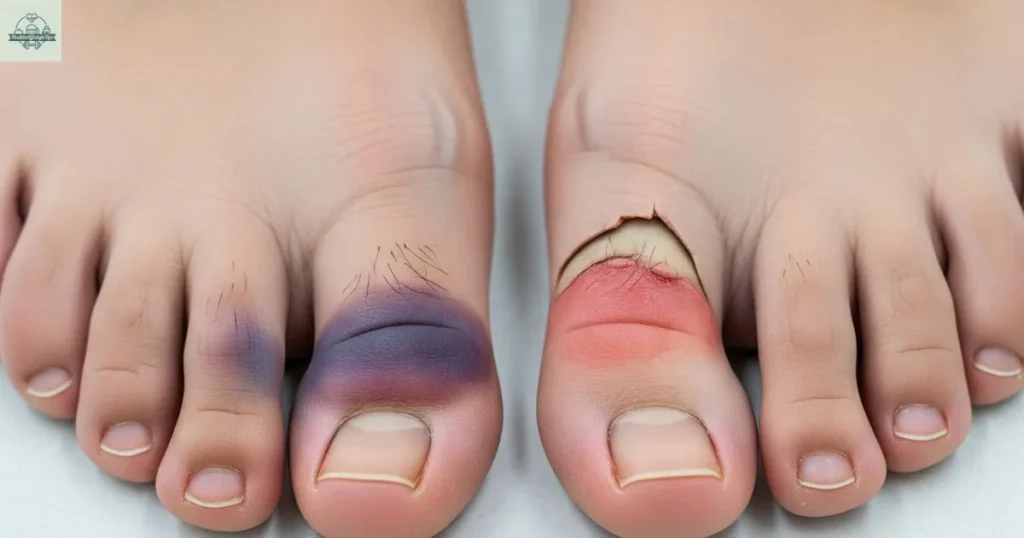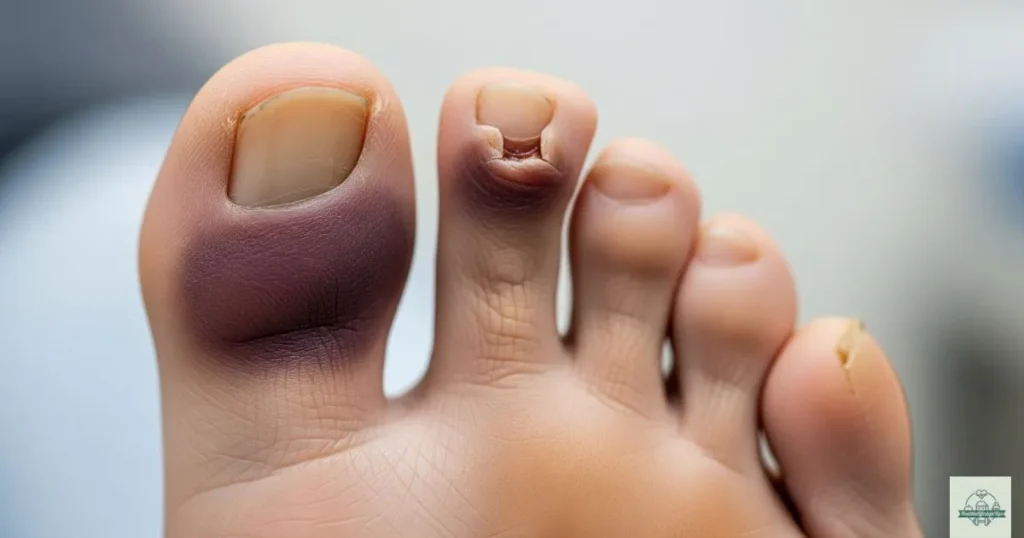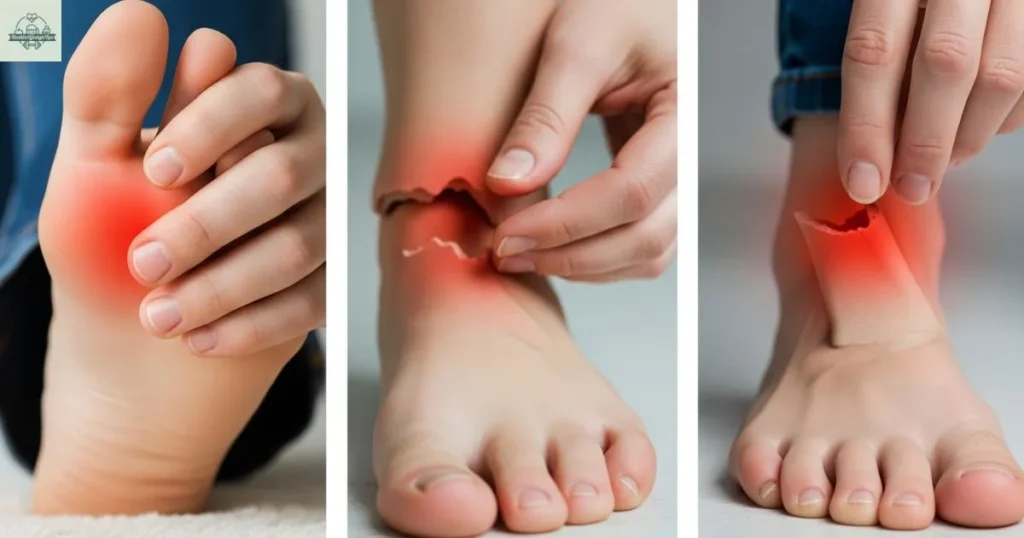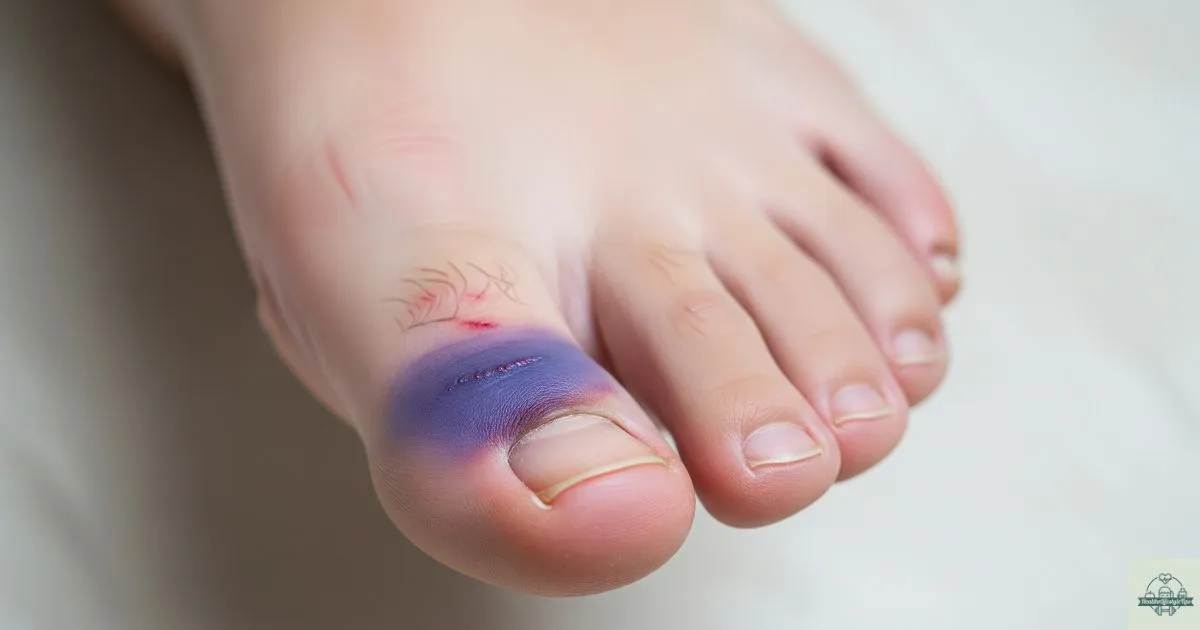A broken toe often looks crooked, swells, or bruises deeply. You may struggle to walk or feel intense pain. A bruised toe might be tender, but it usually heals. For both, rest, ice, and keep it elevated. Avoid walking on it; see a doctor if it’s severe or suspect a fracture.
What’s the Difference Between a Broken and Bruised Toe?

Telling the difference between a bruised toe and a broken toe can feel like solving a tricky puzzle, but there are some clues to help you figure it out. An injured toe usually has mild swelling, tenderness, and discoloration that fades over a few days. You can wiggle it, even if it’s a little stiff.
A broken toe, on the other hand, brings sharper, lasting pain. It might visibly look out of place, swell more severely, and make walking unbearable. If your toe feels crooked or the pain doesn’t ease, it’s time to seek help. Trust your instincts—they’re usually right when it comes to pain.
Broken Toe vs. Stubbed Toe:
Broken Toe Symptoms:
- Sharp, constant pain that doesn’t go away.
- Swelling that spreads beyond the toe, sometimes affecting the whole foot.
- Dark purple or even black bruises, often under the toenail.
- The toe looks bent or out of place.
- Moving it feels almost impossible without severe pain.
Stubbed Toe Symptoms:
- Intense pain initially eases in a few hours or a day.
- Mild swelling and redness around the toe.
- Slight bruising, but nothing severe.
- The toe stays straight, though it’s sore when you touch it.
Quick Check: Compare the hurt toe with the same toe on your other foot. If it looks crooked, swollen, or badly bruised, chances are you’ve got a fracture—not just a stub.
Why Toe Injuries Are Common and Often Misunderstood
Stubbed your toe lately or dropped something on it? You’re not alone—toe injuries happen to everyone, whether walking barefoot or wearing shoes. Our toes work hard daily, but it’s tough to tell if you’re dealing with a simple bruise or something more serious like a broken toe.
The confusion comes because both a bruise and a broken toe can look and feel the same, with swelling, pain, and discoloration. That makes it easy to guess wrong and even ignore a real problem.
But don’t worry! By learning how to spot the signs, you can tell the difference and know what to do if you end up with a broken toe. Let’s make sure your toes get the care they deserve!
Read More: Common Foot Issues People Experience
How Do I Know If My Toe Is Broken or Just Bruised?
Is it a bruise or a broken toe? Start by checking how it feels and looks. A bruised toe tends to hurt but not for long, with mild swelling and discoloration that fades. You can still move it a bit. A broken toe tells a different story—intense, sharp pain, swelling that doesn’t quit, and sometimes a crooked look. If walking’s unbearable or the pain’s relentless, it’s likely broken. When in doubt, don’t tough it out—get it checked!
Immediate First Aid for Toe Injuries
If you suspect a broken toe, quick action is your best friend. Start with the RICE method—Rest, Ice, Compression, and Elevation. Prop your foot up on pillows, apply ice wrapped in a cloth to reduce swelling, and avoid putting weight on your foot. If your toe looks crooked, don’t try to fix it yourself—this calls for a doctor’s care. Remember, a little TLC now can save you pain later!
When Should You See a Doctor?

Sometimes, a broken toe needs more than just rest and ice. If your toe looks bent, feels numb, or you can’t put any weight on it, it’s time to call a doctor. Swelling that doesn’t go down or worsening pain are clear signs you shouldn’t ignore. Also, act fast if the skin around your toe is cut or bleeding. A doctor can check your toe with an X-ray, realign it if needed, and get you on the road to recovery. Don’t wait—quick care makes all the difference!
Treatment Options for a Broken Toe
Treating a broken toe depends on how bad the injury is. Resting and icing your foot can help reduce pain and swelling for mild fractures. Doctors often use “buddy taping,” where the injured toe is gently taped to a healthy one for support. Sometimes, you might need to wear a stiff-soled shoe to protect it while walking. If the bone is crooked, a doctor might straighten it before taping. For severe breaks, surgery could be needed. Acting quickly and following the treatment plan can make all the difference in healing.
Can You Walk on a Broken Toe?
Walking on a broken toe might sound tempting, especially if life is busy—but don’t! A fractured toe needs time to heal; putting; putting weight on it can worsen things. Walking can cause the broken bones to shift, leading to more pain, swelling, or even delayed recovery. Protect your toe with a stiff-soled shoe or a medical boot if you must move around. The best thing you can do is rest, elevate your foot, and give your toe the love and care it deserves. Patience now means faster healing later!
Preventing Toe Injuries
Nobody wants a broken toe, so protecting those little digits is smart! Start by wearing shoes that fit well and have plenty of toe space—no squishing allowed! Watch where you walk, especially barefoot, to avoid stubbing your toes on furniture or stepping on something sharp. If you play sports, invest in protective footwear to guard against accidents. And don’t forget—keeping your surroundings clutter-free reduces trip hazards. A little care now saves your toes (and you) a lot of pain later!
Myths and Misconceptions About Toe Injuries
There’s a lot of confusion regarding toe injuries, especially a broken toe. One common myth is that “there’s nothing you can do for a broken toe”—totally false! Proper treatment, like taping or wearing special footwear, helps it heal correctly. Another misconception? You should always pull on a crooked toe to fix it. Don’t! That can make things worse. Knowing the facts means faster healing and avoiding unnecessary pain. Save your toes by ditching these myths!
Most Common Ways to Break a Toe

Your toes might be tiny, but they’re often the first in line during accidents! Here are the top ways toes end up broken:
- Furniture Collisions – Ouch! Stubbed toes and coffee tables are a painful combo.
- Dropping Heavy Objects – Phones, cans, or tools falling on your foot can cause instant fractures.
- Sports Injuries – Soccer kicks and gymnastics moves put toes at high risk of impact and overuse.
- Slips and Falls – A quick misstep on the stairs or playground can leave your toe throbbing.
Accidents happen, but knowing these risks helps protect your feet and avoid toe troubles.
How to Protect Toes During Sports
Got a future soccer star or gymnast at home? Sports can be tough on toes, but these simple steps keep them safe:
- Choose Quality Shoes – Good shoes designed for their sport offer cushioning and support.
- Add Toe Guards – They absorb impact and prevent fractures during intense play.
- Warm Up First – Stretching and light drills keep feet flexible and lower injury risk.
When kids feel safe, they play harder and with more confidence!
Why Toe Health Matters for Active Families
Think a stubbed or broken toe is no big deal? Think again! Here’s why healthy toes matter:
- Balance & Stability – Strong toes help with running, jumping, and staying steady.
- Long-Term Comfort – Ignoring injuries now can lead to future pain and walking problems.
- Healthy Habits – Teaching kids to care for injuries builds lifelong wellness habits.
Happy toes mean a happy, active family!
Kid-Proof Tips to Prevent Toe Injuries at Home
Want fewer stubbed toes and tears? These easy tips make your home toe-friendly:
- Clear the Floors – No more toys or clutter in walking paths.
- Use Corner Cushions – Soften sharp furniture edges in busy areas.
- Indoor Shoes – Comfy slippers protect toes from bumps.
- Teach Awareness – Remind kids to slow down in tight spaces.
A few small changes can prevent big ouches!
Teach Kids to Spot Serious Toe Injuries
Kids often push through pain, but some injuries need attention. Show them these signs:
- Persistent Pain – If it doesn’t fade, it’s time to tell an adult.
- Odd Shape – Compare with the other foot. If it looks crooked, that’s a warning sign.
- Pain While Moving – If walking hurts, rest is essential.
Helping kids recognize these signs means quicker care and less damage later.
Read More: How to Be a Better Mom
5 FAQs About Broken Toes
How can I tell if my toe is broken or bruised?
A broken toe is usually swollen, discolored, and may look crooked. Pain stays sharp and doesn’t improve quickly. A bruised toe initially feels sore but eases within a day or two.
What should I do right after a toe injury?
Stop walking, apply ice, elevate your foot, and take pain relievers. See a doctor if your toe looks bent or if the pain is severe.
Can I treat a broken toe at home?
Minor fractures can be treated with buddy taping and rest. Severe breaks need medical care.
How long does a broken toe take to heal?
Usually 4–6 weeks, severe injuries may take longer, especially if surgery is needed.
Wrapping Up Toe Care
Your toes might be tiny, but they play a significant role in keeping you moving. Whether you’re dealing with a bruised toe or recovering from a broken toe, caring for them properly is the key to bouncing back. Listen to your body—rest when needed, see a doctor if something feels off, and don’t ignore discomfort. Protect your toes with good footwear and a little extra awareness. Remember, healthy toes equal happy steps, and taking a moment to care for them can save you from bigger issues!
